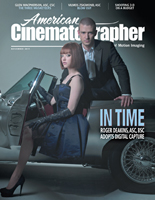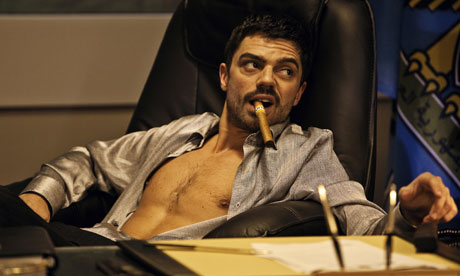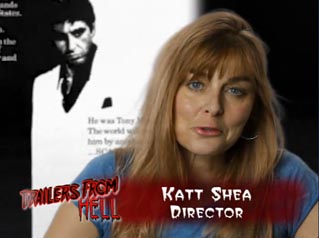ZSIGMOND TALKS 'BLOW OUT'
IN NOVEMBER ISSUE OF AMERICAN CINEMATOGRAPHER, ON STANDS NOW
The November 2011 issue of
American Cinematographer has a nice 9-page article about
Vilmos Zsigmond's work on
Brian De Palma's
Blow Out, which
seems to have finally arrived after being released on DVD and Blu-Ray by
Criterion earlier this year. "Brian is really a stylist, and he's very experimental," Zsigmond tells AC's
Jon Silberg. He sticks his neck out on movies that sometimes get bad reviews because the people who write the reviews say he's concentrating
too much on the visuals. But that's what I like so much about him: he knows about images. There are so many films that just consist of talking heads, and they feel more like what you think of as 'TV coverage.' Brian always wants to do something that has style."
Zsigmond talks about shooting the night scene on the bridge, and the challenges of lighting the shots properly with the slower film stocks of the day (early 1980s). He also talks about the split diopter shots in the film: "You have to plan these shots ahead of time and find a way to hide the vertical line. That's the most important thing. The actors cannot cross that line, because it would look terrible." He mentions that with the types of lenses available today, such shots could be a little easier to do.
Also discussed is Zsigmond's technique of flashing the film, which he did on Blow Out to create less contrast and more shadow detail. This is a technique Zsigmond had developed on previous film projects in order to compensate for the slower film stocks of the day. "I flashed certain things to get more speed out of the film, more shadow detail," Zsigmond tells Silberg. "If we had a big scene-- like the fireworks at the end of Blow Out, where we had to show a whole city block at the port-- I would flash the film at least 10 percent to get a good exposure and detail in the shadows." The article goes on to explain that this was a risky process, involving the threading of exposed and unprocessed negative onto a printer. If there was any mistake made, or some kind of problem with the negative, a large amount of work could be lost for good. Fortunately (and incredibly), this never seemed to happen.
"THE FEWER CUTS YOU HAVE IN A FILM, THE MORE INTERESTING IT IS TO WATCH"
Also discussed is De Palma's penchant for single-take scenes:
"We would sometimes do shots that lasted four or five minutes," the cinematographer recalls. "Brian is very good at that-- he knows exactly what he wants. It's very easy for me to light those kinds of shots on his movies, because I know exactly where he wants the camera to go. And I know he's going to use it all because he loves using those shots-- abd there's no way to cut away. Sometimes he'd go five, six, eight or even 10 takes, knowing that the scene would play out as one shot on the screen."
Zsigmond finds this approach rewarding: "The fewer cuts you have in a film, the more interesting it is to watch the scene. It's like watching real life-- you get up close to people and to the action and let the scene play out. Lately I've enjoyed working with Woody Allen, because he is really aiming for one shot with no coverage. No close-ups, no over-the-shoulders. He wants to move the camera, and he does it in one continuous shot."
For [cinematographer Jan Kiesser, who was Zsigmond's operator on Blow Out], shots like this meant a significant amount of responsibility. "When we were making Blow Out," he says, "we didn't have video playback. It was really on your shoulders as an operator to critically judge composition throughout the shot. You had the best seat in the house for all the critical decisions, like eyelines and framing, but nobody else was going to see the shot until dailies! We were also shooting wide open, so we needed to be very critical about focus."
Michael Gershman was the first AC on Blow Out and worked frequently with Kiesser. "Michael and I started our careers together in animation," says Kiesser, "and we were on many crews togather. Like all great focus pullers, Michael had an uncanny knack for focus-- it was like a sixth sense. On Blow Out, he really had to multi-task, because some of those shots required zooming, focus-pulling and stop changes all at once."
ZSIGMOND: "I NEVER LIKED THE LOOK OF SOME OF THOSE SHOTS AS MUCH AS I DID IN THE BLU-RAY"
The article also discusses the 360-degree shot in Jack's sound studio. "The space wasn't big enough to lay down tracks," Kiesser tells Silberg. "We had the camera in the middle of the room, and we kept panning around and zooming to keep up with the action. In those days, the camera didn't have a battery; it was powered from an external source, so we had to twist the power cable around the tripod and then untwist it during the shot."
Also discussed is the use of the Little Big Crane, which was designed by key grip Richard "Dicky" Deats. "The Little Big Crane let us get into places we might not have been able to access with a larer crane," Kiesser tells Silberg. "We had also used it a lot with Vilmos on Heaven's Gate. This was before remote heads, so I would ride the crane and time the camera movement to the crane's position. My strongest memory of [shooting Blow Out] is sitting up there in the cold and wind."
For the fireworks scenes at the end, according to the article, the production used real fireworks for the wider shots. Zsigmond, who notes that the fireworks were more blown out (or overexposed) than he would have liked, recalls to Silberg, "I brought in as many big lights as I could to bring up the darker areas. I never liked the look of some of those shots as much as I did in the Blu-ray that came out recently. I wasn't involved in timing it, but Brian must have been, or somebody who understood what we were going for, because the colors are more intense than we could get them [photochemically]. Today, we would finish with a DI, and we would have more control." The Criterion transfer of Blow Out was, in fact, supervised by De Palma.
Silberg's article also briefly covers the heartbreaking shot of Jack cradling Sally's body as the camera seems to spin around them:
At the end of the chase, Jack cradles Sally in his arms as the camera spins 360 degrees and reveals the fireworks above them. The shot was one of the film's few optical effects. "The production couldn't possibly create real fireworks in the sky as we spun the camera," Zsigmond explains. "We put the actors and their lighting on a turntable in front of a bluescreen, and we positioned the camera on one side of the turntable facing the bluescreen, where it remained static as we turned the actors around 360 degrees. Because the lighting was moving with the actors, it looked as if the camera was circling them. The fireworks were added in post."
"IT ISN'T IMPORTANT THAT WHAT WE'RE WATCHING IS 'REAL'"
The article concludes with Zsigmond expressing, in Silberg's words, "a particular fondness for the unabashedly stylish films he shot with De Palma" (the other films are Obsession, The Bonfire Of The Vanities, and The Black Dahlia). "I've worked on so many films where we aimed to be 'real,' and we would never have done some of the shots I did with Brian," Zsigmond tells Silberg. "But in a movie by Brian De Palma-- or Hitchcock-- it isn't important that what we're watching is 'real.' We're telling a story, and the most important thing is that the audience has fun watching it."
The magazine, as usual, is worth buying not just for the great article, but also for the terrific array of photographs. The cover story interview with Roger Deakins about his work on Andrew Niccol's new sci-fi thriller In Time is also worth checking out. It's a steal at only $5.95.
 Deadline's Mike Fleming reports tonight that David Ayer, screenwriter of Training Day, has been hired to write the screenplay for Universal's update of Scarface, which is being produced by Martin Bregman and Marc Shmuger. According to Fleming, Ayer is currently completing his third directorial effort, End Of Watch, which he also wrote and produced. If he puts together a decent script, it would not seem such a stretch to think that he might be offered the chance to direct Scarface, as well. Here is what Ayer told Fleming about being chosen to write the new Scarface, which he sounds passionate about:
Deadline's Mike Fleming reports tonight that David Ayer, screenwriter of Training Day, has been hired to write the screenplay for Universal's update of Scarface, which is being produced by Martin Bregman and Marc Shmuger. According to Fleming, Ayer is currently completing his third directorial effort, End Of Watch, which he also wrote and produced. If he puts together a decent script, it would not seem such a stretch to think that he might be offered the chance to direct Scarface, as well. Here is what Ayer told Fleming about being chosen to write the new Scarface, which he sounds passionate about:



 Owen Williams interviewed Billy Drago for a UK film magazine, where it was trimmed down to fit the magazine's space constraints. But Williams has posted the full interview at
Owen Williams interviewed Billy Drago for a UK film magazine, where it was trimmed down to fit the magazine's space constraints. But Williams has posted the full interview at  Lee Tamahori's The Devil's Double is based on the true story of Uday Hussein, Saddam Hussein's ruthless playboy son, and his body double. Dominic Cooper plays the dual roles of Uday and his double, and the film has been compared to Brian De Palma's Scarface ever since the first trailer was released. The film, dubbed everything from "the Iraqi Scarface," to "Scarface in Mesopotamia," has just been released on DVD, so it seems like a good time to post some links that touch on the comparisons.
Lee Tamahori's The Devil's Double is based on the true story of Uday Hussein, Saddam Hussein's ruthless playboy son, and his body double. Dominic Cooper plays the dual roles of Uday and his double, and the film has been compared to Brian De Palma's Scarface ever since the first trailer was released. The film, dubbed everything from "the Iraqi Scarface," to "Scarface in Mesopotamia," has just been released on DVD, so it seems like a good time to post some links that touch on the comparisons. The November 2011 issue of
The November 2011 issue of 

 John Lithgow was
John Lithgow was 
